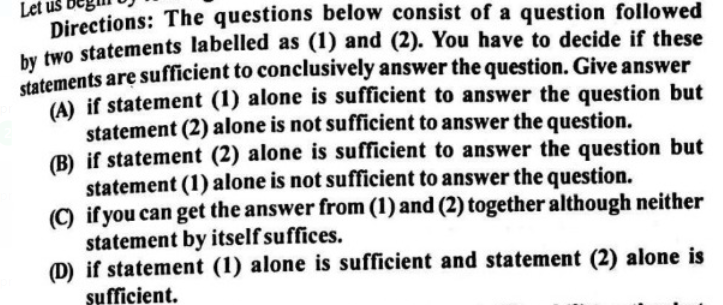
Are some books chocolates?
Statements I. All books are ducks.
Statements II. All ducks are chocolates.
l and II together make a syllogistic problem. We have, A + A = A. Hence, the two statements together imply "All books are chocolates". Hence, "Some books are chocolates" follows, using both the statement together. Hence, conclusion is "C".
Topper's Solved these Questions
- DATA SUFFICIENCYBOOK - M K PANDEYCHAPTER - DATA SUFFICIENCYEXERCISE - Practice Exercises (Type I: Exercise 7A)
50 Videos
- DATA SUFFICIENCYBOOK - M K PANDEYCHAPTER - DATA SUFFICIENCYEXERCISE - Practice Exercises (Type II: Exercise 7B)
50 Videos
- CODED RELATIONSHIPS BOOK - M K PANDEYCHAPTER - CODED RELATIONSHIPS EXERCISE - PRACTICE EXERCISES
35 Videos
- INPUT -OUTPUT (…CONTD.): SHIFTING BOOK - M K PANDEYCHAPTER - INPUT -OUTPUT (…CONTD.): SHIFTING EXERCISE - PRACTICE EXERCISE
52 Videos
Similar Questions
Knowledge Check
In the question two statements are given, followed by two conclusions, I and II. You have to consider the statements to be true even if it seems to be at variance from commonly known facts. You have to decide which of the given conclusions, if any, follows from the given statements.
Statement I: All notebooks are diaries
Statement II: All books are notebooks
Conclusion I: All diaries are books
Conclusion II: All books are diariesAOnly conclusion I followsBOnly conclusion II followsCBoth conclusions I and II followDNeither conclusion I nor conclusion II followsConsider the given statements to be true and decide which of the given Conclusions/assumptions can definitely be drawn from the given statements.
Statements :
1. All cycles are ducks.
2. All ducks are swans.
Conclusions :
I. All swans are cycles.
II. Some swans are cycles.AOnly Conclusion I followsBOnly Conclusion II followsCBoth Conclusion I and Conclusion II followDNeither Conclusion I nor Conclusion II followsRead the given statements and conclusions carefully. Assuming that the information given in the statements is tine, even If it appears to be at variance with commonly known facts, decide which of the given conclusions logically follow(s) from the statements.
Statements:
I. Some books are tables.
II. All tables are chairs.
Conclusions:
I. All books are chairs,
II. Some books are chairs.
III. Some tables are book.
IV. All chairs are book.AOnly conclusion I follows.BOnly conclusions II and III follow.COnly conclusions IL III and IV followDOnly conclusions I and IV follow.
In the following question below are given some statements followed by some conclusions. Taking the given statements to be true even if they seem to be at variance from commonly known facts, read all the conclusions and then decide which of the given conclusion logically follows the given statements.
Statements: I. All cups are plates
II. All books are cups.
Conclusions:
I. All plates are books.
II. All books are plates.
View SolutionIn the following question below are given some statements followed by some conclusions. Taking the given statements to be true eve if they seem to be at variance from commonly known facts, read all the conclusion and then decide which of the given conclusion logically follows the given statements.
Statements :
I. All books are pens
II. All pens are tables
Conclusions :
I. Some pens are tables
II. All tables are books.
View SolutionConsider the given statement(s) to be true and decide which of the given conclusions/assumptions can definitely be drawn from the given statements.
Statements :
1. All books are trees.
2. All trees are lions.
Conclusions:
I. All books are lions.
II. All lions are books.
III. All trees are books.
IV. Some lions are books.
View SolutionIn the following question below are given some statements followed by some conclusions. Taking the given statements to be true even if they seem to be at variance from commonly known facts, read all the conclusions and then decide which of the given conclusion logically follows the given statements.
Statements:
I. All books are thick.
II. Some thick are white.
Conclusions:
I. Some books are white.
II. Some books are not white.
View SolutionStatements: Many bucks are ducks.
All trucks are ducks.
Conclusions: I Some ducks are not bucks.
II Some bucks are trucks.
III Some ducks are trucks.
IV. All ducks are trucks.
View Solution
